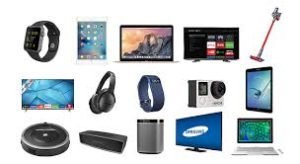
Smartphones are versatile, handheld devices that combine the functionality of a mobile phone with computing capabilities. They allow users to make calls, send messages, browse the internet, run applications, and much more. Here’s a detailed look at the features and descriptions of smartphones:
Key Features of Smartphones:
- Display:
- Description: The screen is a crucial component, often touch-sensitive and varying in size and resolution.
- Types:
- LCD (Liquid Crystal Display): Common in budget and mid-range phones.
- OLED (Organic Light Emitting Diode): Found in higher-end models, known for vibrant colors and deep blacks.
- AMOLED (Active Matrix OLED): An advanced form of OLED with better color accuracy and energy efficiency.
- Features: High resolution (Full HD, Quad HD, 4K), high refresh rate (90Hz, 120Hz), and various screen sizes.
- Processor (CPU):
- Description: The central processing unit is the brain of the smartphone, determining its speed and efficiency.
- Types: Qualcomm Snapdragon, Apple A-series, Samsung Exynos, MediaTek.
- Features: Multi-core processors (dual-core, quad-core, octa-core), varying clock speeds, AI capabilities.
- Operating System (OS):
- Description: The software platform that manages hardware and software resources.
- Types:
- iOS: Exclusive to Apple devices, known for its smooth user experience and ecosystem integration.
- Android: Used by various manufacturers, highly customizable, with a wide range of app availability.
- Camera:
- Description: An essential feature for capturing photos and videos.
- Types: Single, dual, triple, or quad-camera setups.
- Features:
- Resolution: Measured in megapixels (MP), higher MP generally means better detail.
- Lenses: Wide-angle, ultra-wide, telephoto, macro.
- Other Features: Optical image stabilization (OIS), night mode, portrait mode, 4K/8K video recording.
- Battery:
- Description: Powers the smartphone, with varying capacities and charging technologies.
- Features:
- Capacity: Measured in milliampere-hours (mAh), higher capacity usually means longer battery life.
- Charging: Fast charging, wireless charging, reverse wireless charging.
- Storage:
- Description: Memory for storing apps, media, and files.
- Types:
- Internal Storage: Fixed capacity (e.g., 64GB, 128GB, 256GB).
- Expandable Storage: Via microSD card (in some models).
- RAM: Random Access Memory, affects multitasking and performance (e.g., 4GB, 8GB, 12GB).
- Connectivity:
- Description: Methods for connecting to networks and other devices.
- Features:
- Cellular: 4G LTE, 5G for faster internet speeds.
- Wi-Fi: Dual-band support (2.4GHz and 5GHz), Wi-Fi 6.
- Bluetooth: For connecting to peripherals like headphones, smartwatches.
- NFC: Near Field Communication for contactless payments.
- Build and Design:
- Description: Physical appearance and durability.
- Materials: Glass, metal, plastic.
- Design Features: Slim profiles, bezel-less displays, water and dust resistance (IP ratings).
- Security:
- Description: Protects user data and device access.
- Features:
- Biometric Authentication: Fingerprint scanner, facial recognition.
- Encryption: Data encryption for security.
- Additional Features:
- Sensors: Accelerometer, gyroscope, proximity sensor, ambient light sensor, barometer.
- Audio: Stereo speakers, headphone jack (in some models), high-resolution audio support.
- Software Enhancements: Custom UI skins (e.g., Samsung One UI, Xiaomi MIUI), regular updates.
Popular Smartphones and Their Features:
- Apple iPhone 13 Pro:
- Description: A high-end smartphone with advanced features.
- Features:
- 6.1-inch Super Retina XDR OLED display
- A15 Bionic chip
- Triple-camera system (12MP wide, ultra-wide, telephoto)
- 5G connectivity
- iOS 15 operating system
- Up to 1TB of storage
- Ceramic Shield front cover
- IP68 water and dust resistance
- Samsung Galaxy S21 Ultra:
- Description: A flagship Android phone with top-tier specs.
- Features:
- 6.8-inch Dynamic AMOLED 2X display, 120Hz refresh rate
- Exynos 2100 or Snapdragon 888 (depending on region)
- Quad-camera system (108MP wide, 12MP ultra-wide, dual 10MP telephoto)
- 5G connectivity
- Up to 16GB RAM and 512GB storage
- S Pen support
- IP68 water and dust resistance
- Google Pixel 6 Pro:
- Description: Known for its clean Android experience and excellent camera.
- Features:
- 6.7-inch LTPO AMOLED display, 120Hz refresh rate
- Google Tensor processor
- Triple-camera system (50MP wide, 12MP ultra-wide, 48MP telephoto)
- 5G connectivity
- Up to 12GB RAM and 512GB storage
- Android 12 with exclusive Pixel features
- OnePlus 9 Pro:
- Description: A premium phone with a focus on performance and fast charging.
- Features:
- 6.7-inch Fluid AMOLED display, 120Hz refresh rate
- Snapdragon 888 processor
- Quad-camera system (48MP wide, 50MP ultra-wide, 8MP telephoto, 2MP monochrome)
- 5G connectivity
- Up to 12GB RAM and 256GB storage
- Warp Charge 65T and Warp Charge 50 Wireless
Choosing the Right Smartphone:
When selecting a smartphone, consider the following factors:
- Purpose: Identify primary uses (e.g., photography, gaming, productivity).
- Budget: Determine how much you are willing to spend.
- Operating System: Choose between iOS and Android based on your preference and ecosystem compatibility.
- Features: Prioritize features that are important to you, such as camera quality, battery life, display quality, and storage capacity.
- Reviews: Check expert reviews and user feedback to gauge real-world performance and reliability.
- Future Proofing: Consider future updates and 5G support for longevity.
By understanding these features and considerations, you can choose a smartphone that best meets your needs and preferences.








